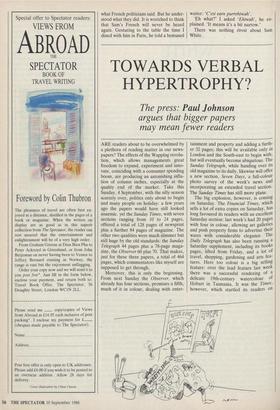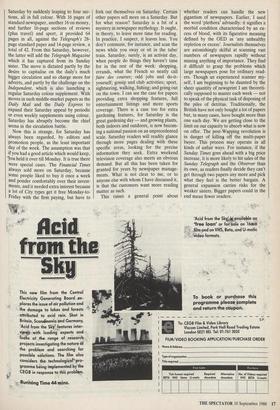TOWARDS VERBAL HYPERTROPHY?
The press: Paul Johnson
argues that bigger papers may mean fewer readers
ARE readers about to be overwhelmed by a plethora of reading matter in our news- papers? The effects of the Wapping revolu- tion, which allows managements great freedom to expand, experiment and inno- vate, coinciding with a consumer spending boom, are producing an astonishing infla- tion of column inches, especially at the quality end of the market. Take this Sunday, 4 September, with the silly season scarcely over, politics only about to begin and many people on holiday: a few years ago the papers would have still looked anaemic. yet the Sunday Times, with seven sections ranging from 10 to 24 pages, offered a total of 128 pages of newsprint plus a further 84 pages of magazine. The other two qualities were much slimmer but still huge by the old standards: the Sunday Telegraph 44 pages plus a 78-page maga- zine, the Observer 60 plus 70. That makes, just for these three papers, a total of 464 pages, which commentators like myself are supposed to get through.
Moreover, this is only the beginning. From next Sunday the Observer, which already has four sections, promises a fifth, much of it in colour, dealing with enter- tainment and property and adding a furth- er 32 pages; this will be available only in London and the South-east to begin with, but will eventually become ubiquitous. The Sunday Telegraph, while handing over its old magazine to its daily, likewise will offer a new section, Seven Days, a full-colour photo survey of the week's news and incorporating an extended travel section. The Sunday Times has still more plans. The big explosion, however, is coming on Saturday. The Financial Times, which sells a lot of extra copies on Saturday, has long favoured its readers with an excellent Saturday section: last week's had 20 pages with four in colour, allowing art galleries and posh property firms to advertise their wares with considerable elegance. The Daily Telegraph has also been running a Saturday supplement, including its books pages, lifted from Friday, and a lot of travel, shopping, gardening and arts fea- tures. Here too colour is a big selling feature: over the lead feature last week there was a successful rendering of a delicate 19th-century watercolour of Hobart in Tasmania. It was the Times, however, which startled its readers on Saturday by suddenly leaping to four sec- tions, all in full colour. With 16 pages of standard newspaper, another 16 on money, and further 16-page sections of reviews (plus travel) and sport, it provided 64 pages in all, against the Telegraph's 28- page standard paper and 14-page review, a total of 42. From this Saturday, however, the latter will add the Telegraph Magazine which it has captured from its Sunday sister. The move is dictated partly by the desire to capitalise on the daily's much bigger circulation and so charge more for adverts, and partly by the challenge on the Independent, which is also launching a regular Saturday colour supplement. With moves in such middle-market papers as the Daily Mail and the Daily Express to expand their Saturday appeal by periodic or even weekly supplements using colour, Saturday has abruptly become the chief arena in the circulation battle.
Now this is strange, for Saturday has always been regarded, by editors and promotion people, as the least important day of the week. The assumption was that if you had a good article which would keep, you held it over till Monday. It is true there were special cases. The Financial Times always sold more on Saturday, because some people liked to buy it once a week and ponder comfortably over their invest- ments, and it needed extra interest because a lot of City types get it free Monday-to- Friday with the firm paying, but have to fork out themselves on Saturday. Certain other papers sell more on a Saturday. But for what reason? Saturday is a bit of a mystery in newspaper mythology. It ought, in theory, to leave more time for reading. In practice, I suspect, it leaves less. You don't commute, for instance, and scan the news while you sway or sit in the tube/ train. Saturday, surely, is an activist day, when people do things they haven't time for in the rest of the week: shopping, errands, what the French so neatly call faire des courses; odd jobs and do-it- yourself; gossip and club activities; sport, sightseeing, walking, fishing; and going out on the town. I can see the case for papers providing extra shopping features, full entertainment listings and more sports coverage. There is a case too for extra gardening features, for Saturday is the great gardening day — and growing plants, both indoors and outdoors, is now becom- ing a national passion on an unprecedented scale. Saturday readers will readily glance through more pages dealing with these specific areas, looking for the precise information they seek. Extra weekend television coverage also meets an obvious demand. But all this has been taken for granted for years by newspaper manage- ments. What is not clear to me, or to anyone else with whom I have discussed it, is that the customers want more reading matter as such.
This raises a general point about whether readers can handle the new gigantism of newspapers. Earlier, I used the word 'plethora' advisedly: it signifies a morbid condition characterised by an ex- cess of blood, with its figurative meaning defined by the OED as 'any unhealthy repletion or excess'. Journalists themselves are astonishingly skilful at scanning vast numbers of newspapers rapidly without missing anything of importance. They find it difficult to grasp the problems which large newspapers pose for ordinary read- ers. Though an experienced scanner my- self, I am beginning to be daunted by the sheer quantity of newsprint I am theoreti- cally supposed to master each week — not to speak of the physical task of disposing of the piles of detritus. Traditionally, the British have not only bought a lot of papers but, in many cases, have bought more than one each day. We are getting close to the limit on our capacity to absorb what is now on offer. The post-Wapping revolution is in danger of killing off the multi-paper buyer. This process may operate in all kinds of unfair ways. For instance, if the Sunday Times goes ahead with a big price increase, it is more likely to hit sales of the Sunday Telegraph and the Observer than its own, as readers finally decide they can't get through two papers any more and pick what they feel is the better bargain. A general expansion carries risks for the weaker sisters. Bigger papers could in the end mean fewer readers.























































 Previous page
Previous page